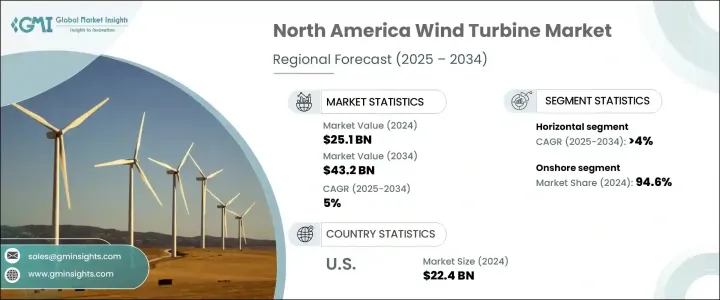PUBLISHER: Global Market Insights Inc. | PRODUCT CODE: 1698593

PUBLISHER: Global Market Insights Inc. | PRODUCT CODE: 1698593
North America Wind Turbine Market Opportunity, Growth Drivers, Industry Trend Analysis, and Forecast 2025-2034
North America Wind Turbine Market was valued at USD 25.1 billion in 2024 and is projected to grow at a CAGR of 5% from 2025 to 2034. Continuous technological advancements have played a key role in improving efficiency, reliability, and performance. Innovations in materials, manufacturing techniques, aerodynamics, and digitalization have enabled the development of larger and more efficient turbines, ultimately driving down energy costs.

The increasing transition toward electrification and the rising need to reduce dependence on conventional energy sources are expected to propel clean electricity generation, creating significant market expansion opportunities. The growing cost of traditional power generation, along with the increasing demand for enhanced energy security, has fueled investments in wind power infrastructure. Favorable government policies promoting cost-effective and advanced wind power solutions further strengthen the industry landscape. Wind energy has become one of the fastest-growing renewable electricity sources, supporting sustainability goals and climate change mitigation.
| Market Scope | |
|---|---|
| Start Year | 2024 |
| Forecast Year | 2025-2034 |
| Start Value | $25.1 Billion |
| Forecast Value | $43.2 Billion |
| CAGR | 5% |
The expansion of grid-connected wind turbine installations and their growing cost competitiveness compared to conventional power sources such as coal and natural gas will support market penetration. The rising wind power capacity across North America and ambitious renewable energy targets are key factors driving market growth. The horizontal-axis wind turbine segment is expected to witness over 4% CAGR through 2034, primarily due to its increasing adoption in large-scale onshore and offshore wind projects. Continuous technological advancements have enhanced efficiency, reliability, and performance, making horizontal-axis wind turbines the preferred choice for utility-scale applications. These turbines incorporate variable speed generators, intelligent control systems, and longer blades, allowing them to capture more wind energy while operating efficiently under varying conditions. Their capability to optimize power generation by adjusting blade pitch makes them suitable for high-wind locations, further increasing their deployment across commercial and utility projects.
Vertical-axis wind turbines are also gaining traction due to continuous advancements in design and an increasing shift toward replacing conventional technologies with more efficient solutions. Their advantages, such as low starting wind speeds, simplified maintenance, operational flexibility, and lower costs compared to horizontal-axis wind turbines, contribute to their growing adoption. The onshore wind turbine segment accounted for over 94.6% of the North America market share in 2024. The availability of vast wind resources across regions such as the Great Plains, the Midwest, and coastal areas makes onshore wind power one of the most cost-effective electricity generation methods. The declining Levelized Cost of Electricity (LCOE) has further boosted the economic feasibility of onshore wind projects, driving adoption across the region.
The offshore wind turbine market is set to grow at over 9% CAGR through 2034, driven by improved efficiency, reduced environmental impact, and increased space availability. Companies are focusing on developing advanced solutions tailored to extreme environmental conditions, supported by ongoing research and development initiatives.
The U.S. wind turbine market recorded USD 22.4 billion in 2024, reflecting strong government support through policies, tax incentives, and investment opportunities. Technological advancements continue to enhance cost efficiency and energy output, further encouraging the adoption of wind power solutions across the country.
Table of Contents
Chapter 1 Methodology & Scope
- 1.1 Research Design
- 1.2 Base estimates & calculations
- 1.3 Forecast model
- 1.4 Primary research & validation
- 1.4.1 Primary sources
- 1.4.2 Data mining sources
- 1.5 Market definitions
Chapter 2 Industry Insights
- 2.1 Industry ecosystem
- 2.2 Regulatory landscape
- 2.3 Industry impact forces
- 2.3.1 Growth drivers
- 2.3.2 Industry pitfalls & challenges
- 2.4 Growth potential analysis
- 2.5 Porter's analysis
- 2.5.1 Bargaining power of suppliers
- 2.5.2 Bargaining power of buyers
- 2.5.3 Threat of new entrants
- 2.5.4 Threat of substitutes
- 2.6 PESTEL analysis
Chapter 3 Competitive landscape, 2024
- 3.1 Introduction
- 3.2 Strategic dashboard
- 3.3 Innovation & technology landscape
Chapter 4 Market Size and Forecast, By Rating, 2021 – 2034 (USD Million & MW)
- 4.1 Key trends
- 4.2 < 100 kW
- 4.3 100 kW to 250 kW
- 4.4 > 250 kW to 500 kW
- 4.5 > 500 kW to 1 MW
- 4.6 1 MW to 2 MW
- 4.7 > 2 MW
Chapter 5 Market Size and Forecast, By Axis, 2021 – 2034 (USD Million & MW)
- 5.1 Key trends
- 5.2 Horizontal
- 5.2.1 Up-wind
- 5.2.2 Down-wind
- 5.3 Vertical
Chapter 6 Market Size and Forecast, By Installation, 2021 – 2034 (USD Million & MW)
- 6.1 Key trends
- 6.2 Onshore
- 6.3 Offshore
Chapter 7 Market Size and Forecast, By Connectivity, 2021 – 2034 (USD Million & MW)
- 7.1 Key trends
- 7.2 Grid connected
- 7.3 Standalone
Chapter 8 Market Size and Forecast, By Application, 2021 – 2034 (USD Million & MW)
- 8.1 Key trends
- 8.2 Residential
- 8.3 Commercial & Industrial
- 8.4 Utility
Chapter 9 Market Size and Forecast, By Component, 2021 – 2034 (USD Million & MW)
- 9.1 Key trends
- 9.2 Blades
- 9.3 Towers
- 9.4 Others
Chapter 10 Market Size and Forecast, By Country, 2021 – 2034 (USD Million & MW)
- 10.1 Key trends
- 10.2 U.S.
- 10.3 Canada
- 10.4 Mexico
Chapter 11 Company Profiles
- 11.1 ATB GROUP
- 11.2 Envision Group
- 11.3 General Electric
- 11.4 Goldwind Americas
- 11.5 NORDEX
- 11.6 ReGen Powertech
- 11.7 Senvion
- 11.8 Siemens Gamesa Renewable Energy
- 11.9 Suzlon Energy Limited
- 11.10 Vestas




